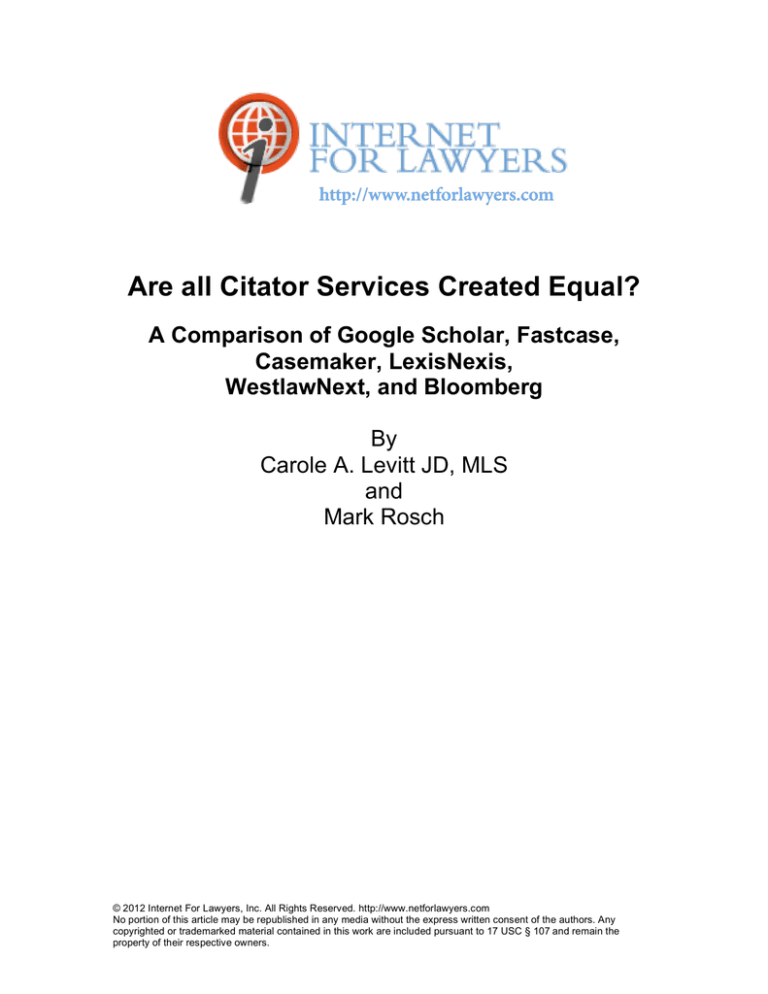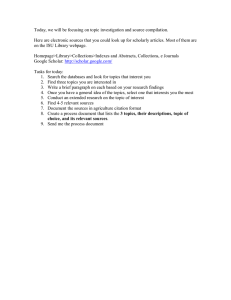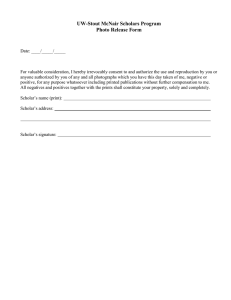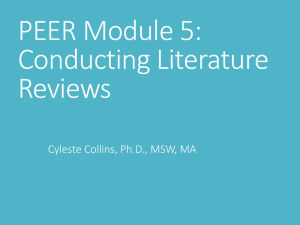
Are all Citator Services Created Equal?
A Comparison of Google Scholar, Fastcase,
Casemaker, LexisNexis,
WestlawNext, and Bloomberg
By
Carole A. Levitt JD, MLS
and
Mark Rosch
© 2012 Internet For Lawyers, Inc. All Rights Reserved. http://www.netforlawyers.com
No portion of this article may be republished in any media without the express written consent of the authors. Any
copyrighted or trademarked material contained in this work are included pursuant to 17 USC § 107 and remain the
property of their respective owners.
Are all Citator Services Created Equal?
A Comparison of Google Scholar, Fastcase, Casemaker, LexisNexis,
WestlawNext, and Bloomberg
During our live continuing legal education seminars we discuss how to use the
information found in social media profiles for evidence and how to get profiles
admitted into evidence. If a profile owner assumes a pseudonym, authenticating
the owner of the profile has proven to be a challenge. Some courts admit the
profile into evidence and some do not. For that reason, we’ve been following
Tienda v. State, an unpublished Texas Appellate Court case, where a murderer
appealed his conviction, arguing that the trial court erred in admitting evidence
from his Myspace profile because there was no proof he had created and
maintained that profile. Tienda v. State, No. 05-09-00553-CR (Tex. App.—Dallas,
December 17, 2010) (do not publish), available at http://linkon.in/IhNLsK. The
profile included the following information about the appellant convicted murderer:
the pseudonym “Smiley,” which he was known by according to testifying
witnesses; photographs of the appellant, with one photo displaying his electronic
monitor and another photo displaying his tattoo; references to the murder; and
email addresses that incorporated both the name “Smiley” and his real name. He
asserted that the profile had not been authenticated. The appeals court rejected
his assertion and affirmed the trial court’s decision that had relied in part on the
following evidence:
The inherent nature of social networking websites encourages
members who choose to use pseudonyms to identify themselves by
posting profile pictures or descriptions of their physical appearances,
personal backgrounds, and lifestyles. This type of individualization is
significant in authenticating a particular profile page as having been
created by the person depicted in it. The more particular and
individualized the information, the greater the support for a
reasonable juror's finding that the person depicted supplied the
information.
As we prepare for more in-person MCLE seminars around the country, we
wanted to see how prevalent this line of thinking was. We also thought it would
be a good opportunity to compare three of the most popular free and low-cost
case law databases (Google Scholar, Fastcase, Casemaker) and their citator
services, with the more expensive databases (LexisNexis, WestlawNext, and
Bloomberg) and their citator services. It goes without saying that Google Scholar,
Fastcase, Casemaker’s citators do not provide the editorial comment that
LexisNexis, WestlawNext, and Bloomberg do. Instead, we were focusing on
how well each citator worked. We decided to use the 2010 Tienda case for our
test case to see if each citator listed the same citing opinions to Tienda. And, of
course, we wanted to learn if the 2010 Tienda case was still good law.
© 2012 Internet For Lawyers, Inc. All Rights Reserved. http://www.netforlawyers.com
No portion of this article may be republished in any media without the express written consent of the authors.
Any copyrighted or trademarked material contained in this work are included pursuant to 17 USC § 107 and
remain the property of their respective owners.
1
In previous research, we’ve been pretty satisfied with Google Scholar, Fastcase,
and Casemaker’s citators…until we ran this search.
Google Scholar
Using Google Scholar to update the 2010 Tienda v. State decision, we were
informed by the “How this document has been cited” feature of Scholar’s “How
Cited” citator that, “We [Google Scholar] could not find any documents that cite
this one” and in the “Cited by” feature of Scholar’s “How Cited” citator that, “We
[Google Scholar] could not determine how this case has been cited.” (See the
illustration below.) This indicated that Tienda had not been appealed or cited to in
another opinion, which we later learned was not correct when we decided to
double-check Scholar’s ”How Cited” results by running a search through the
Google Scholar database using Tienda and myspace as our keywords.
© 2012 Internet For Lawyers, Inc. All Rights Reserved. http://www.netforlawyers.com
No portion of this article may be republished in any media without the express written consent of the authors.
Any copyrighted or trademarked material contained in this work are included pursuant to 17 USC § 107 and
remain the property of their respective owners.
2
In addition to finding the original 2010 Tienda opinion, we found two results that
the Google Scholar citator service did not find:
•
•
Manuel v State, a 2011 opinion that cited to the 2010 Tienda opinion; and
An opinion that affirmed the 2010 Tienda opinion (Tienda v. State, No.
PD-0312-11 (Tex. Crim. App.—Dallas, February 8, 2012), available at
http://linkon.in/L1DKfz).
•
Although the 2010Tienda opinion had not been reversed or overruled and was
still “good law,” we were troubled that Google Scholar’s “How cited” had not
found the affirming 2012 Criminal Appeals case even though both opinions are in
the Google Scholar database.
The first reason we were troubled was, as we all learned in our legal research
class, we need to cite to the opinion decided by the highest court and
Google Scholar’s “How Cited” missed that opinion. The second reason we were
troubled was that if we were in a state where we weren’t allowed to cite to an
unpublished case, we never would have known that a published opinion that we
could cite to even existed. Missing the 2012 opinion would have been extremely
embarrassing (and possibly even malpractice).
Did Fastcase or Casemaker’s citators do any better than Google Scholar’s? No.
© 2012 Internet For Lawyers, Inc. All Rights Reserved. http://www.netforlawyers.com
No portion of this article may be republished in any media without the express written consent of the authors.
Any copyrighted or trademarked material contained in this work are included pursuant to 17 USC § 107 and
remain the property of their respective owners.
3
Fastcase
The 3rd opinion returned in the Fastcase search results list illustrated below is our
2010 Tienda Court of Appeals “do not publish” opinion. The 1st opinion is the
2012 Court of Criminal Appeals of Texas opinion which affirmed the 2010 Tienda
opinion, but in the “Authority Check” columns (similar to Google Scholar’s “How
cited” and Casemaker’s “Cite Check”) both opinions show “0” results, indicating
to us that Tienda had not been appealed or cited to in another opinion. Unless
we read each case, we would not know that one opinion had affirmed the other.
Casemaker
As noted earlier, Casemaker’s CaseCheck (similar to Google Scholar’s “How
cited” and Fastcase’s “Authority Check”) did not do any better. As shown in the
illustration below, as you are viewing the 2010 Tienda opinion, there is a “0” next
to “Case check which indicates that Tienda had not been appealed or cited to in
another opinion despite the fact that the affirming decision is also in the
Casemaker database. (It’s a bit hard to see the “0”, but if you look at the grey bar
below the search box, notice “Case check” (the text is orange) and next to that is
the “0” In black.)
© 2012 Internet For Lawyers, Inc. All Rights Reserved. http://www.netforlawyers.com
No portion of this article may be republished in any media without the express written consent of the authors.
Any copyrighted or trademarked material contained in this work are included pursuant to 17 USC § 107 and
remain the property of their respective owners.
4
Aside from CaseCheck, Casemaker also offers a separate subscription-based
product, CaseCheck +, which provides editorial treatment to alert researchers to
subsequent negative treatment of any case they're currently viewing (a green
thumbs up means “No negative treatment in subsequent cases” while a red
thumbs down means there is negative treatment). CaseCheck + also does not
include unpublished opinions.
How Did They Miss it?
We don’t know why Google Scholar failed to find that the unpublished lower court
opinion in Tienda was affirmed by the higher court because Google Scholar has
very little documentation and no “contact us.”
We were, however, able to talk to the CEOs of both Casemaker and Fastcase for
an explanation as to why their databases failed to find that the lower court
opinion in Tienda was affirmed by the higher court. Although the affirming court
refers to the lower court opinion by name and docket number, Fastcase’s CEO
Ed Walters explained that, ”The reason in Fastcase is that Authority Check is
algorithmic — we show later citations to cases, and that currently relies on the
citation — so unpublished opinions don't get represented (emphasis added).
Authority Check does not editorially flag negative treatment — instead, it shows
© 2012 Internet For Lawyers, Inc. All Rights Reserved. http://www.netforlawyers.com
No portion of this article may be republished in any media without the express written consent of the authors.
Any copyrighted or trademarked material contained in this work are included pursuant to 17 USC § 107 and
remain the property of their respective owners.
5
all later-citing cases, and pulls out the citing paragraph, so you can see the
court's treatment at a glance. Authority Check is an automated system that
identifies later-citing cases, but it is not a citator (emphasis added), and does not
include editorial information telling you whether your case is still good law. Before
relying on the continuing validity of cases, we recommend that you use
Shepard's ($) or KeyCite ($). These services are available online by subscription
and at your local law library.” (AUTHOR’S NOTE: Shepard's and KeyCite are not
available by subscription as stand-alone products. You would have to subscribe
to Lexis and Westlaw to use their citators. Both databases in the past year or so
have also discontinued their credit card service, so you can no longer Shepardize
or KeyCite on an ad hoc basis.)
Dave Harriman, Casemaker’s CEO explained that Casemaker also doesn’t
include unpublished opinions in CaseCheck or in its separate subscription-based
product, CaseCheck +. CaseCheck + only shows negative history, so even if
Casemaker’s CaseCheck + did include unpublished opinions, we would not have
learned about the affirming 2012 Tienda opinion since it was positive history.
Even for published opinions, merely looking for “negative” history is troubling to
us for the two reasons we noted earlier in our Google Scholar discussion.
However, Casemaker’s CaseCheck + will eventually include positive history. This
is being worked on now and Texas opinions will be the first ones to show positive
history. This still doesn’t solve our unpublished opinions problem.
LexisNexis/Shepard’s, WestlawNext/KeyCite, and Bloomberg/BCite
LexisNexis, WestlawNext, and Bloomberg (and their citator services) all found
that the Criminal Court of Appeals Court of Texas affirmed the Texas Appellate
Court’s 2010 Tienda opinion. They also found that the 2011 Manuel v State
opinion cited to the 2010 Tienda opinion.
© 2012 Internet For Lawyers, Inc. All Rights Reserved. http://www.netforlawyers.com
No portion of this article may be republished in any media without the express written consent of the authors.
Any copyrighted or trademarked material contained in this work are included pursuant to 17 USC § 107 and
remain the property of their respective owners.
6
See the next two illustrations below for the LexisNexis and Shepard’s results
(research and illustrations provided by Cookie Lewis, M.S.L.S., Askinfomania,
www.askinfomania.com):
© 2012 Internet For Lawyers, Inc. All Rights Reserved. http://www.netforlawyers.com
No portion of this article may be republished in any media without the express written consent of the authors.
Any copyrighted or trademarked material contained in this work are included pursuant to 17 USC § 107 and
remain the property of their respective owners.
7
See the next two illustrations for WestlawNext’s KeyCite (research and
illustrations provided by Kevin Gerson, UCLA Law Library Director and Lecturer
in Law, gerson@law.ucla.edu):
© 2012 Internet For Lawyers, Inc. All Rights Reserved. http://www.netforlawyers.com
No portion of this article may be republished in any media without the express written consent of the authors.
Any copyrighted or trademarked material contained in this work are included pursuant to 17 USC § 107 and
remain the property of their respective owners.
8
See the next illustration for Bloomberg’s BCite (research and illustrations
provided by Kevin Gerson, UCLA Law Library Director and Lecturer in Law,
gerson@law.ucla.edu):
Citator Conclusion
So, what’s a legal researcher to do if they don’t have access to LexisNexis,
WestlawNext, or Bloomberg’s citator services? While we recommend NOT
relying entirely on any of the citator services provided by Google Scholar,
Fastcase, or Casemaker, legal researchers can still use these databases to learn
if their cases are still good law by taking the extra step to run a search using the
party names as keywords (e.g., tienda and state). This will find all opinions with
those same party names. You’ll need to read the resulting cases (but only those
decided after your case was decided) and then discern for yourself how the
subsequent cases treated your case.
If there are too many results because one or both of the party names are
common names (e.g., state), add a unique keyword from the opinion to your
search just as we did when we added myspace to our Tienda keyword search
(e.g., tienda and myspace). However, if a higher court reversed or overruled
Tienda but did not mention myspace, then we would have missed this. So, a
© 2012 Internet For Lawyers, Inc. All Rights Reserved. http://www.netforlawyers.com
No portion of this article may be republished in any media without the express written consent of the authors.
Any copyrighted or trademarked material contained in this work are included pursuant to 17 USC § 107 and
remain the property of their respective owners.
9
better tactic might be to do a broad search for the party name and just review the
opinions that were decided after your case’s decision date.
For Casemaker, there is a combined search option (see illustration below) that
includes a Case Name search box (in addition to keyword, date, etc.). So instead
of searching tienda as a keyword, you could enter tienda into the Case Name
search box and enter myspace into the Keyword search box. We would even add
dates to the Date search boxes (e.g., 1/1/2010 to 11/28/2012 (or the date you run
your search) to limit the search. Once again, see the caveat (above) about
entering the word myspace into the Keyword search box. You might be safer to
just enter the case name and the date range. Google Scholar and Fastcase do
not offer Case Name searches.
For a state case, run the search in the state’s case law database and also in the
U.S. Supreme Court’s case law database (in case it was appealed to and
decided by the U.S. Supreme Court). For federal cases, run the search in the
federal case law database (U.S. District, Appellate, and Supreme Court).
© 2012 Internet For Lawyers, Inc. All Rights Reserved. http://www.netforlawyers.com
No portion of this article may be republished in any media without the express written consent of the authors.
Any copyrighted or trademarked material contained in this work are included pursuant to 17 USC § 107 and
remain the property of their respective owners.
10
Social Media Profile Authentication Conclusion
For those following social media profile authentication cases and wondering what
the 2012 Court of Criminal Appeals of Texas Tienda court held, they affirmed the
unpublished 2010 opinion:
This combination of facts—(1) the numerous photographs of the appellant
with his unique arm, body, and neck tattoos, as well as his distinctive
eyeglasses and earring; (2) the reference to David Valadez's death and
the music from his funeral; (3) the references to the appellant's "Tango
Blast" gang; and (4) the messages referring to (a) a shooting at "Rumors"
with "Nu-Nu,"(b) Hector as a "snitch,"[49]and (c) the user having been on
a monitor for a year (coupled with the photograph of the appellant
lounging in a chair displaying an ankle monitor) sent from the MySpace
pages of "ron Mr. T" or "MR. SMILEY FACE" whose email address is
"ronnietiendajr@"—is sufficient to support a finding by a rational jury that
the MySpace pages that the State offered into evidence were created by
the appellant. This is ample circumstantial evidence—taken as a whole
with all of the individual, particular details considered in combination—to
support a finding that the MySpace pages belonged to the appellant and
that he created and maintained them…
Because there was sufficient circumstantial evidence to support a finding
that the exhibits were what they purported to be—MySpace pages the
contents of which the appellant was responsible for—we affirm the trial
judge and the court of appeals which had both concluded the same.
The Court of Criminal Appeals of Texas 2012 Tienda opinion acknowledged that
the Maryland opinion upon which the court of appeals had relied upon in a case
with similar facts, has since been reversed [Griffin v. State, 419 Md. 343, 19 A.3d
415 (2011)], but stated:
Nevertheless, as we have explained, there are far more circumstantial
indicia of authenticity in this case than in Griffin—enough, we think, to
support a prima facie case that would justify admitting the evidence and
submitting the ultimate question of authenticity to the jury. We hold that
the court of appeals did not err to conclude that it was within the trial
court's discretion to admit the MySpace postings, notwithstanding that the
persuasive authority it relied upon for that proposition has since been
overruled.
© 2012 Internet For Lawyers, Inc. All Rights Reserved. http://www.netforlawyers.com
No portion of this article may be republished in any media without the express written consent of the authors.
Any copyrighted or trademarked material contained in this work are included pursuant to 17 USC § 107 and
remain the property of their respective owners.
11




